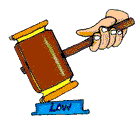Evidence can be the most important part of a trial. It can either convict the accused, or set them free. There are specific types of evidence, and ways this evidence may be used during a trial. What evidence is and how it may be used will be explained here.
 There are four different types of evidence, they are:
There are four different types of evidence, they are:
- Witness Testimony, given under oath.
- Exhibits that are tangible items admitted at the proceedings.
- Stipulated facts to which the lawyers have agreed.
- Judicial notice of facts that are common knowledge.
Witness testimonies may come in two different varieties. They can be either a lay witness or expert witness. The lay witness can be like you or me, regular everyday people, who testifies as to matters of which we have personal knowledge.
The expert witness would be a psychiatrist or other professional who gives testimony about conclusions he or she has drawn based on his or her expertise on any given subject.
Exhibits usually come in three varieties which are:
- Real evidence, such as the actual gun that shot the victim, or a torn and stained piece of clothing, worn by a woman who was attacked and raped.
- Demonstrative exhibits are created evidence rather than “real” evidence. Examples such as pictures of the crime scene and how it was found. Or an example can be demonstrated on another person as to how the victim could have been strangled.
- Documented exhibits such as business records, diaries, letters, and court transcripts are just a few of the types of documents that may be used during a trial. Documentary exhibits are something of a hybrid in that they contain testimony, but they are “tangible,” (Something you can touch), and available for the trier-of-fact to scrutinize.
Stipulated facts are evidence. When there is no factual dispute about certain information, the proper way for the information to be offered is by stipulation. They are entered into between parties through counsel and are reviewed by the court. Stipulated facts are provided in writing or are read to the trier-of-fact.
Judicial notice is taken of those items the court believes are “common knowledge.” Such information is presented to the trier-of-fact, without any proof. The court does not take judicial notice often though, but is does occur. Common knowledge can be anything that the public already knows, like the Grand Canyon is in Arizona, or the United States consists of 50 states. Judicial notice is rarely used and in order to introduce evidence, there must be either a qualified witness to talk about it, display it, or a stipulation from the opposing counsel agreeing to it.
There are also some things that are not allowed into evidence and do not qualify, they are:
- Statements, arguments, questions, or objections made by attorneys.
- Information obtained outside the court room by the judge or jurors, which is not part of the proceedings.
- Testimony that the court specifically strikes or excludes.
- Testimony or exhibits admitted for limited purposes by the court are not evidence for anything other than the limited purpose for which they court admitted them.
- Jury instructions given to the jury by the judge
Our judicial system covers the entire society and the consequences of incorrect evidence can cause insurmountable damage to a person or a group of people, there must be a more formalized and reliable way of getting to the truth. Both sides have the right to tell their side of the story. However, in order to avoid injustice, the system must restrict the giving of information in such a way as to both promote truth and avoid mistakes to the greatest extent possible. Rules of evidence exist to safeguard against injustice, as much as possible. What is equal is for one, must be equal for all.